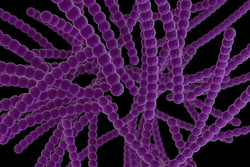Novel drugs against gram-negative bacteria
Gram-negative bacteria — such as Escherichia coli and Salmonella — cannot retain the crystal violet dye used in the gram-staining protocol. This is due to their complex outer envelope, which is formed by two flexible membranes that together maintain the integrity and shape of the cell. Due to this complexity these bacteria are less susceptible to antibiotics than those that do not contain a second membrane. To address this issue, the EU funded the project 'Exploiting gram-negative cell division targets in the test tube to obtain anti-microbial compounds' (DIVINOCELL)(opens in new window). The main focus was to inhibit bacterial proliferation by blocking known and novel targets in the process of cell division and envelope synthesis. This was carried out using E. coli as a model bacterium to screen various antimicrobial compounds that interfere with its proliferation. During E. coli proliferation, several proteins (FtsZ, FtsA and ZipA) assemble in the middle of the cell to form a division ring. Failure to do so results in bacterial death. DIVINOCELL developed an assay to screen for inhibitors of cell wall synthesis as well as a positive whole-cell assay based on properties of E. coli peptidoglycan hydrolase mutants. These assays helped to screen the library of compounds provided by partners. Using models for the active centre of FtsZ, in silico procedures have identified three molecules that inhibit the activity of the protein and are active against E. coli. From a collection of kinase inhibitors, new inhibitors of in vitro FtsZ polymeriszation have been identified that induce the misplacement of division components. Additional compounds also modified the interaction of FtsZ with ZipA and the interaction between FtsZ and FtsA. One of them was active against Burkholderia thailandensis, a multidrug-resistant bacterium. From a Streptomyces strain extract researchers obtained a new antimicrobial with a broad action spectrum. These compounds are currently at different phases of intellectual property protection. DIVINOCELL participants have published over 63 papers in top-ranking scientific journals and have participated in over 80 dissemination activities targeting the general public. Overall, project discoveries promise to open up new avenues for studying microbial proliferation and developing antibiotics to cure infections.







